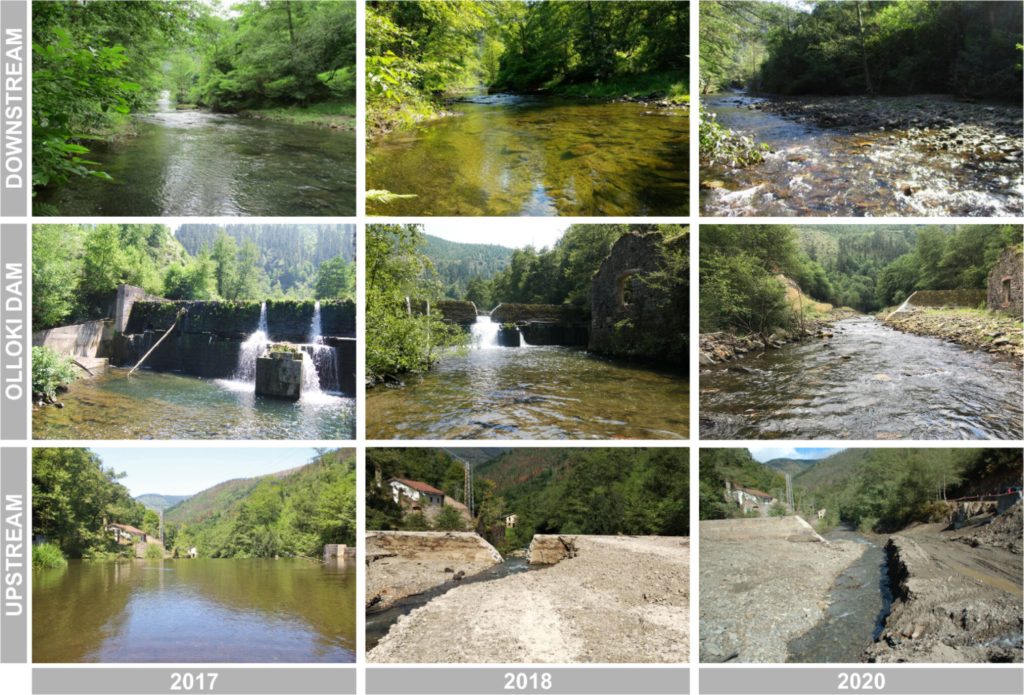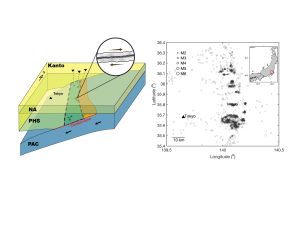
Askoa Ibisate, a geographer specializing in fluvial geomorphology, has analyzed how the disappearance of the Olloki dam affects sediment transport. Ibisate concluded that the volume of pebbles mobilized by the demolition has increased, and their journey has been extended. The results are particularly significant because the monitoring work has been ongoing for seven years and the authorities are provided with valuable information for predicting the consequences of dam demolition. The work is published in the journal Geomorphology.
Thanks to the momentum of European Union policies, disused dams are being removed for the purpose of restoring rivers. One example of this is the Olloki dam (Gipuzkoa), which was the subject of a study by fluvial geomorphology geographers from the Fluvial Functioning research group. The dam used to be located in Leitzaran and was demolished, above all, to improve the habitat of the salmon. In fact, for the river to function properly and for the habitats to be in a good condition, the geomorphology of the river has to function correctly.
Among other things, it is very important to renew the riverbed and, to do this, the transport of sediments and water flows must be adequate: “Rivers are a transport system and if they are to fulfill their ecological function, they need to move water, sediments, nutrients and living beings. But it is the dams themselves that create obstacles. We say they are like blood clots that form in veins,” explained Ibisate.
In this context, to demonstrate the true effectiveness of the removal of the dam, the work by the UPV/EHU analyzed how the demolition has affected the transport of sediments throughout the whole process: “We knew the river would recover, but we didn’t know how. Nor in what way different points of the river would be affected. So we measured the movement of the pebbles in three specific locations, before, during and after the demolition of the dam.
“The results show a significant increase in the volumes of sediment transported, especially along the stretches under the influence of the dam, and that the stones have traveled longer distances than expected,” Ibisate explained.
In terms of the amount of sediment mobilized, the study indicates that the number of displaced stones has increased, especially after the dam was completely demolished, although Ibisate was keen to clarify that this occurred gradually. In other words, these movements did not occur suddenly: “When it comes to demolishing dams, one of the fears is that the sediment accumulated over the years will suddenly be displaced like a wave and, as a result, the uses and infrastructure located on the flood plain downstream will be damaged. What we have in fact seen is that the process is regulated and the stones are transported gradually.”
It was stressed that the study provides information that is of great help to the authorities when planning dam demolitions. Although in each case the specific characteristics of the streams need to be looked at, the research makes it possible to better understand the functioning of rivers and the sediment flow regime; that way, the geomorphological responses to the demolition of the dams can be predicted, and a specific strategy designed.
The UPV/EHU researcher also highlighted the displacement of the stones: “There are stones that traveled 8.8 kilometers in one year, and that’s a lot. We didn’t think the sediments would move so much, and the other experts in the field were also surprised.”
Discover the latest in science, tech, and space with over 100,000 subscribers who rely on Phys.org for daily insights.
Sign up for our free newsletter and get updates on breakthroughs,
innovations, and research that matter—daily or weekly.
1,800 stones monitored over 7 years
To obtain the results, during the seven years that the research was in progress, 1,800 stones (300 each year) were released at three points in the river: in two areas affected by the dam (one upstream, one downstream) and at a control site beyond its influence. “The control point enabled us to discover that the changes in the transport of sediments caused by the demolition of the dam were actually due to the demolition itself and not to other factors, such as, for example, a significant increase,” Ibisate said.
The stones distributed around Leitzaran had a code embedded inside them. So to find out how much sediment had moved, they inspected the river using a detector (similar to a metal detector): “When the device detects a code, it informs us which stone it is and gives us the GPS coordinates. So we know where we released it, where it has appeared and, therefore, how far it has traveled,” explained Ibisate.
The researchers said it was a monumental task, as the river had to be scanned, meter by meter, over a distance of 11 kilometers from bank to bank, and because it was monitored over a seven-year period. However, the fact that it has been working for so long is precisely what has made the UPV/EHU research so valuable: “Normally, due to lack of funding, monitoring is carried out for 1–2 years, before and shortly after the dam has been demolished. By contrast, we deposited the first stones in 2016, and over the following six years we were able to see how far they had got.
“Meanwhile, during the summers of 2018 and 2019, the wall was demolished in two phases and, subsequently, we monitored the movement of the sediments until 2022. So we had the opportunity to collect information for three full years after the entire dam had been demolished. It is a very long period of time and, so, the results are significant,” Ibisate added.
What is more, in recent years there have been a whole range of hydrological conditions, which makes the information gathered even more enriching. In fact, after the demolition of the dam it was also possible to measure the influence of the flow rates on the transport of sediments.
More information:
A. Ibisate et al, Bedload response to dam removal: Results from a 6-year particle tracking survey in the Leitzaran River (Basque Country), Geomorphology (2024). DOI: 10.1016/j.geomorph.2024.109542
Provided by
University of the Basque Country
Citation:
Sediment transport restored after demolition of the Olloki dam (2025, February 26)
retrieved 26 February 2025
from https://phys.org/news/2025-02-sediment-demolition-olloki.html
This document is subject to copyright. Apart from any fair dealing for the purpose of private study or research, no
part may be reproduced without the written permission. The content is provided for information purposes only.








